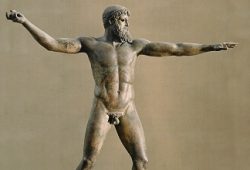The Real Kama Sutra: More Than An Ancient Sex Manual
 Posted On
Posted On
Everyone knows the Kama Sutra is ancient India’s racy sex manual. The very title conjures up titillating visions of smiling maharajas cavorting with bejeweled naked nymphs.

But few Americans have ever read it—not even the “good parts,” the sexual positions that made the book famous. Meanwhile, the major English translation is a travesty. It dates from 1883 and was published just once in the U.S., in 1962. Its author, English army officer Richard Burton, tortured the text to shoehorn it into Victorian views about sexuality, notably the that only men experience sexual desire and pleasure, and that women are simply passive receptacles for men’s lust. The real Kama Sutra expresses much different—and more contemporary—attitudes.
Happily, in 2009, some 1700 years after the book first appeared, Oxford University Press published a little noticed translation by Wendy Doniger, a professor of religious history at the University of Chicago, and Sudhir Kakar, an Indian fellow at Harvard’s Center for Study of World Religions. They right Burton’s wrongs and reveal the Kama Sutra as a guide to an eroticized life. Think “Sex and the City” circa 300 A.D., only for men.
The recent translation can be remarkably modern: Women are as sexual as men, and men should provide them with erotic pleasure and orgasms. But it can also be callous and repugnant: If women stubbornly spurn men’s advances, men are justified in raping them. And oddly, the licentious Kama Sutra can be surprisingly prudish: It disdains oral sex.
Treatise On Sexual Pleasure
Kama Sutra means “treatise on sexual pleasure.” Unlike the Christian view that sex is only for procreation, fourth-century Hindus reveled in eroticism, believing that life has three purposes: piety (dharma), prosperity (artha), and sex (kama).They considered the pursuit of sexual pleasure a religious quest—as if doing it were as important as church on Easter.
The sexual culture described in the Kama Sutra is surprisingly liberal. It grants women independence that modern Saudi women can only dream of. While it describes girls and women as dependent on their fathers and husbands, it depicts young women as free to date men and select their own husbands, and married women as free to entertain lovers.
Life as an Erotic Play in Seven Acts
Nothing is known about the Kama Sutra’s author except his name, Vatsyayana Mallanaga, but it’s clear he was upper class. He takes money, leisure, and servants for granted.
The Kama Sutra contains seven sections that track men through life. In Book One, the bachelor sets up his pad. In Book Two, the section that gave the book its racy reputation, he perfects his sexual techniques. In Book Three, he seduces a virgin. In Book Four, he marries and creates a home for his wife and servants. By Book Five, he’s sexually bored with his wife sexually, so he seduces other men’s wives. But as he ages, philandering become exhausting, so in Book Six he takes up with courtesans, who please him while expecting nothing in return—except payment. Finally, in old age, his erections fail him, so Book Seven contains herbal potency formulas.
Book Two, the sex manual, recognizes women as lusty, and urges men to value their erotic pleasure, a view that arrived in our culture less than a century ago. It also exhorts men to make love so that “she enjoys her climax first.” How? By cuddling, kissing, and playful sensual touch to heighten women’s arousal, elements of lovemaking that still elude some men. The Kama Sutra is also adventurous—it touts sex toys, sex while bathing, and erotic spanking. It describes how a man can satisfy two women at once (fondle one by hand while having intercourse with the other), and how two men can share one woman (fellatio for one, intercourse for the other).
I mentioned the book’s unexpected aversion to oral sex, which Vatsyayana calls “opposed to the moral code.” But after condemning it, he instructs women how to “suck the mango” and tutors men in cunnilingus: “Transpose the procedure for kissing a mouth.”

When seducing virgins, the Kama Sutra advises men to be patient and tender. Over several weeks, suitors should engage them in conversation, shower them with gifts, and win their trust, while keeping hands off. Then men should send figurines of goats with erections. If virgins react positively, their suitors get lucky.
But if virgins are too coy, tenderness goes out the window. Vatsyayana advocates plying reluctant virgins with liquor and then raping them. Other women may also be forced, “widows, women who have no male protector, wandering ascetics, and beggars … for they are vulnerable.”
The Kama Sutra ignores caring for one’s own spouse, focusing instead on the thrills of seducing other men’s wives. If ancient Indian wives discovered their husbands’ infidelity, they could not divorce. All they could do was chastise and practice “love sorcery,” concocting herbal potions to win their husbands back. But the Kama Sutra forbids love sorcery because, it says, women had no right to interfere with men’s adultery. The book cites only one reason to pass up infidelity—if it risked “disaster,” i.e. violence or financial reverses.
Of course, if men seduced neighbors’ wives, other itchy gents were likely to seduce theirs. The Kama Sutra warns husbands how to prevent it—constant surveillance bordering on imprisonment.
In the end, the Kama Sutra describes a strange lusty world that venerated sex for its own sake, while also accepting men’s sexual cruelty toward women. Why read it today? Because the Kama Sutra ushers us into an exotic society’s bedroom and shows us a mirror in which we see reflections of ourselves.


